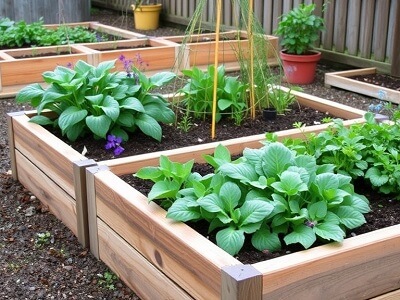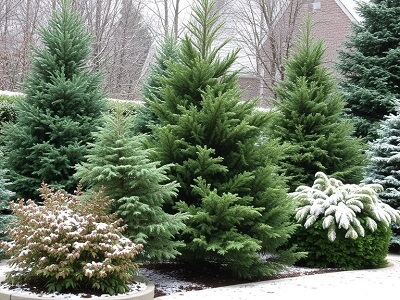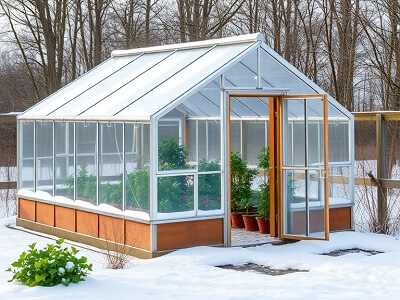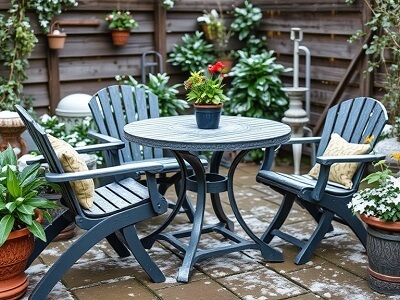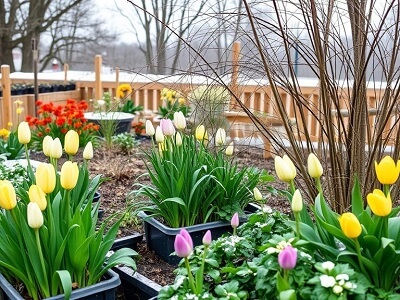 Preparing your garden over winter helps ensure a healthier, more vibrant garden when spring arrives. Winter is the perfect time to tackle essential tasks like soil care, mulching, pruning, and maintenance, so your garden will thrive in the growing season. Here’s a list of top winter garden tasks to keep your garden in great shape for spring.
Preparing your garden over winter helps ensure a healthier, more vibrant garden when spring arrives. Winter is the perfect time to tackle essential tasks like soil care, mulching, pruning, and maintenance, so your garden will thrive in the growing season. Here’s a list of top winter garden tasks to keep your garden in great shape for spring.
1. Clean and Prepare Garden Beds
Removing debris and dead plant material from your beds in winter reduces the risk of pests and diseases that may overwinter in old foliage.
- Remove Dead Plants and Weeds: Clear away any dead annuals, perennial foliage, and weeds. Compost what you can, and discard diseased plants to prevent spreading pathogens.
- Turn Over the Soil: Loosen and aerate compacted soil with a garden fork or tiller to improve drainage and aeration for spring planting.
- Add Organic Matter: Spread a layer of compost or well-rotted manure over beds to replenish nutrients. This organic matter will break down over winter, enriching the soil for spring crops.
Cleaning and prepping garden beds over winter creates a fresh start, allowing new plants to establish in healthier soil.
2. Mulch Garden Beds for Protection
Applying mulch in winter shields the soil from temperature extremes, suppresses weeds, and helps retain moisture.
- Choose the Right Mulch: Organic mulches like straw, shredded leaves, or bark provide insulation and break down to add nutrients. Apply a layer about 2-4 inches thick around plants, but leave space around stems to prevent rot.
- Apply Mulch After the First Freeze: Wait until the ground freezes to apply mulch, helping the soil maintain consistent temperatures through winter.
- Protect Bulbs and Perennials: Mulching over bulbs and perennials helps prevent premature sprouting during warm spells, ensuring they emerge at the right time in spring.
Mulching protects the soil structure and plant roots, promoting healthier spring growth with less maintenance.
3. Prune Trees and Shrubs
Winter is an ideal time to prune many trees and shrubs while they’re dormant, as it minimizes stress on plants and allows you to see their structure clearly.
- Focus on Deciduous Trees and Shrubs: Remove dead, diseased, or crossing branches to promote better airflow and reduce the risk of disease.
- Prune Flowering Shrubs at the Right Time: Prune shrubs that flower on new wood (like roses and hydrangeas) in late winter. For those that bloom on old wood (like lilacs), wait until after they flower in spring.
- Use Sharp, Clean Tools: Pruning with sharp tools ensures clean cuts, which help plants heal faster and reduce the risk of disease.
Pruning in winter encourages healthy growth and shapes plants to produce a stronger spring and summer display.
4. Protect Perennials and Tender Plants
Certain plants need extra protection to survive winter conditions, especially in areas with harsh freezes.
- Add Extra Mulch or a Frost Blanket: Cover the base of perennials and any tender plants with mulch or a frost cloth to insulate roots from extreme cold.
- Bring Tender Plants Indoors: If you have potted plants or tender species, move them to a sheltered spot, such as a greenhouse, garage, or indoors to keep them alive over winter.
- Wrap Shrubs or Use Burlap for Protection: For shrubs vulnerable to frost damage, wrap them in burlap or frost cloth, especially in areas prone to heavy snow.
Protecting tender plants prevents winter dieback and gives delicate perennials a strong start in spring.
5. Plan and Order Spring Seeds
Winter is a great time to start planning your garden and ordering seeds, especially for early spring and summer crops.
- Review Your Garden Layout: Decide on which crops and flowers you want to grow and how you’ll arrange them in the garden.
- Order Seeds Early: Ordering seeds in winter ensures you get the best selection, as popular varieties can sell out quickly.
- Start Seeds Indoors if Needed: If you’re growing cool-season crops like onions or lettuce, start seeds indoors in late winter to get a jump on the season.
Planning and ordering seeds early allows you to be ready to plant as soon as the soil warms up in spring.
6. Maintain and Store Garden Tools
Taking time to clean and care for your tools over winter extends their lifespan and ensures they’re ready for spring.
- Clean and Sharpen Tools: Remove soil and debris from tools, and sharpen pruners, shears, and blades to keep them effective.
- Oil Metal Parts: Apply a thin layer of oil to prevent rust on metal tools, especially if they’ll be stored in a damp area.
- Organize and Store Tools Properly: Hang or store tools in a dry, sheltered spot like a shed or garage to keep them in top condition.
Well-maintained tools make garden tasks easier and help prevent plant damage during pruning and planting.
7. Inspect Garden Structures and Fences
Check and repair garden structures like trellises, fences, and raised beds during winter when they’re less crowded by plants.
- Examine for Damage: Look for loose or damaged parts, such as fence boards, bed walls, or broken stakes, and make necessary repairs.
- Add Protective Coatings: Apply paint or sealant to wooden structures to protect them from winter weather.
- Reinforce if Needed: If your area experiences strong winds or heavy snowfall, reinforce vulnerable structures to prevent winter damage.
Inspecting and repairing garden structures keeps them in good shape and ready to support your plants in spring.
8. Prepare for Winter Wildlife Visitors
Helping wildlife survive winter can be rewarding and beneficial for your garden’s ecosystem.
- Add Bird Feeders and Fresh Water: Feeders provide food for birds when other sources are scarce, while a heated bird bath or water source keeps them hydrated.
- Create Brush Piles or Shelters: Piles of twigs, leaves, or stones give birds and small animals shelter from the cold.
- Leave Some Seed Heads: Leave a few seed heads on perennials like coneflowers to provide a natural food source for birds.
Supporting wildlife enhances biodiversity, and many birds and beneficial insects will naturally help control pests in your garden.
9. Keep an Eye on Frost and Snow
Snow and frost can be beneficial but also potentially damaging for plants and garden structures.
- Shake Off Heavy Snow: Gently shake snow off the branches of shrubs and trees to prevent breakage from heavy accumulation.
- Cover Frost-Sensitive Plants: Use frost blankets or cloches on frosty nights to protect tender plants and extend their growing season.
- Use Snow as Insulation: A light layer of snow can act as natural insulation, protecting plants from extreme cold.
Managing snow and frost ensures your plants are protected without being damaged by the weight of ice or snow.
Final Tips for Winter Garden Prep
Taking the time to winterize your garden ensures that everything is set up for success in spring. From cleaning and mulching to planning and pruning, winter is a season for preparation, giving your garden the best chance to flourish when warmer weather returns. These essential tasks will not only keep your garden healthy during the cold months but also make spring gardening smoother and more enjoyable.

